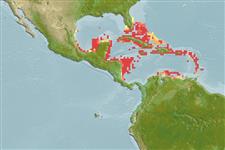>
Ovalentaria/misc (Various families in series Ovalentaria) >
Opistognathidae (Jawfishes)
Etymology: Opistognathus: Greek, opisthe = behind + Greek, gnathos = jaw (Ref. 45335); to the very elongate upper jaw of the type species of the genus, Opistognathus nigromarginatus (Ref. 128653).
More on author: Poey.
Environment: milieu / climate zone / depth range / distribution range
Ecologia
marino associati a barriera corallina; distribuzione batimetrica 1 - 8 m (Ref. 89891). Tropical; 29°N - 10°N, 98°W - 59°W
Western Atlantic: southern Florida, USA and Bahamas to Central America, West Indies and Caribbean Islands.
Size / Peso / Age
Maturity: Lm ? range ? - ? cm
Max length : 13.0 cm TL maschio/sesso non determinato; (Ref. 7251)
Short description
Morfologia | Morfometria
Spine dorsali (totale): 11; Raggi dorsali molli (totale): 15; Spine anali 3; Raggi anali molli: 15. Black spot in the dorsal fin is in the lower half of the fin and is usually located between the 6th and 9th spines; there is some brown pigment at the corner of the mouth but no black and white bands inside the maxilla (Ref. 13442).
Inhabits an elaborate burrow, often fairly deep (12 inches), and with a terminal chamber; the vertical shaft lined with coral and shell fragments. An oral brooder (Ref. 5521).
Life cycle and mating behavior
Maturità | Riproduzione | Deposizione | Uova | Fecundity | Larve
Males incubate the eggs in the mouth (Ref. 33037, 39363).
Robins, C.R. and G.C. Ray, 1986. A field guide to Atlantic coast fishes of North America. Houghton Mifflin Company, Boston, U.S.A. 354 p. (Ref. 7251)
IUCN Red List Status (Ref. 130435)
Threat to humans
Harmless
Human uses
Acquario: Commerciale
Informazioni ulteriori
Age/SizeAccrescimentoLength-weightLength-lengthLength-frequenciesMorfometriaMorfologiaLarveDinamica popolazioni larvaliReclutamentoAbbondanzaBRUVS
BibliografiaAcquacolturaProfilo di acquacolturaVarietàGeneticaElectrophoresesEreditarietàMalattieElaborazioneNutrientsMass conversion
Strumenti
Special reports
Download XML
Fonti Internet
Estimates based on models
Preferred temperature (Ref.
123201): 26.4 - 28.1, mean 27.4 °C (based on 476 cells).
Phylogenetic diversity index (Ref.
82804): PD
50 = 0.5000 [Uniqueness, from 0.5 = low to 2.0 = high].
Bayesian length-weight: a=0.00389 (0.00180 - 0.00842), b=3.12 (2.94 - 3.30), in cm total length, based on all LWR estimates for this body shape (Ref.
93245).
Trophic level (Ref.
69278): 3.5 ±0.5 se; based on size and trophs of closest relatives
Fishing Vulnerability (Ref.
59153): Low vulnerability (10 of 100).
Nutrients (Ref.
124155): Calcium = 121 [62, 189] mg/100g; Iron = 0.719 [0.415, 1.204] mg/100g; Protein = 18.4 [17.3, 19.5] %; Omega3 = 0.0847 [, ] g/100g; Selenium = 21.6 [9.7, 45.7] μg/100g; VitaminA = 135 [43, 410] μg/100g; Zinc = 2.01 [1.34, 2.86] mg/100g (wet weight);
